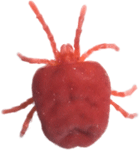| |
Harvest Mites (chiggers)

A magnified view of a Harvest mite |
|
Harvest mites (also known as red bugs, or in their larvae stage, chiggers) these are mites in the family Trombiculidae that live in forests and grasslands. It is possible to see the minute red mites moving rapidly over the skin surface. In their larval stage they will attach to various animals, rodents, birds, and humans. Their bite produces small, raised red welts on the skin accompanied by intense itching. The mites are active throughout the summer to the end of September, being particularly troublesome around August. This relative of the tick is almost microscopic, and may be seen as small red or orange dots measuring 0.4 mm: just about visible to the eye, and has a chrome orange hue. A common species of harvest mites in Northern America is Trombicula Alfreddugesi: in the U. K. the most prevalent harvest mite is the Trombicula Autumnalis. This mite can cause considerable discomfort to humans and animals. These can be picked up by dogs and on humans by walking in fields etc: They can inadvertently be placed in the cages of rabbits, hamsters, and other rodents by using grasses or leaves collected from infected areas
The eggs laid by the adult in the spring and summer hatch into the six legged harvest mites. These are most abundant in late summer and autumn. The first active stage in the life of the harvest mites is this six legged larva, and this is the time it attacks warm blooded animals. They are active only during the day and their movements are controlled primarily by the weather. They are most active when it is dry and sunny, and least active when it is cold and wet. When the larvae come into contact with a warm blooded animal they will swarm on to it and attach themselves.
The insertion of their small fangs into the skin is painless. This is intended to pierce the skin so that the feeding process can begin. Once fixed on to their host the larval mites feed on skin cells, not blood. The larvae inject a digestive enzyme into the skin which breaks down the cells of the underlying layers of the skin. The liquid food resulting from this process is sucked back into the digestive system of the larvae. They do not actually "bite" but form a hole in the skin and chew up tiny parts of the inner layers of the skin. Intense irritation and swelling is caused and the animal may scratch and lick continuously until the mite has been dislodged.
Some temporary relief may occur until it is able to reattach itself again. The alternation of the injecting and sucking, then continues for two or three days until the larvae is fully fed, and has increased three to four times its size
Contrary to popular belief that it burrows into the skin to feed and lay eggs. Harvest mites are non-burrowing mites and since the larva is sexually immature it cannot lay eggs. During the period of feeding the harvest mites do not change its position on its host, once the larva has finished feeding it drops to the ground to complete its life cycle. After a period of five to six week it changes into an eight legged nymph, at this stage, like the larva, it is still sexually immature, but resembles very closely the adult male or female into which it eventually develops, the mites cease to be parasitic at this stage.
Diagnosis is best made by a veterinarian who will identify the mite and distinguish it from other parasites that can cause similar symptoms
See Mites
|
|


